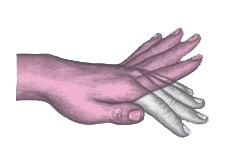This page is under development
The sialidoses are the least common of the major forms of PME69. The term "sialidosis" refers to lysosomal enzyme defects arising from a deficiency of neuraminidase (sialidase), the enzyme which cleaves the terminal sialyl linkages of several oligosaccharides and glycoproteins165. Deficiency of the enzyme results in intralysosomal storage of glycoproteins in neuronal cells166. Sialidoses have also been referred to as mucolipidosis I, since the first patients described with this enzyme abnormality shared features of both the mucopolysaccharidoses and the sphingolipidoses 166. Subsequently a separate group of patients, the cherry-red spot-myoclonus syndrome, was described. These patients presented in adolescence and adulthood, and are now referred to as sialidosis type I 167 168.
The disorder is characterized by:
- Visual loss.
- A cherry-red spot on fundoscopy.
- Myoclonus, often associated with simultaneous polyspike and wave discharge on EEG.
- No mental deterioration.
1.6.7.2 Inheritance
The various forms of sialidosis are inherited in an AR manner 165.
1.6.7.3 Myoclonus
Stimulation, movement, or emotion usually induces the myoclonus 167. As the disease progresses, the myoclonus may interfere with walking and sitting, and become so severe that it results in impaired bulbar function 48, particularly since the myoclonus is resistant to therapy50. Generalized seizures in two patients have been noted to be the climax of a series of myoclonic jerks 167.
1.6.7.4 Clinical Manifestations
The primary neuraminidase deficiencies can be divided into two groups 165.
Sialidosis-type I (primary neuraminidase deficiency without dysmorphism):
The illness begins in adolescence (range 8-29 years) and patients usually have normal growth, physical appearance, and intellect169. This form is associated with the myoclonus-cherry-red spot phenotype, with severe myoclonus, progressive visual failure, tonic-clonic seizures and ataxia69;170. Lens opacities and a mild peripheral neuropathy may occur 69.
Sialidosis-type II:
Congenital, infantile and juvenile types occur, with mental retardation being the predominant feature of the first two types 170. Patients are more severely affected than in type I, with early onset of a progressive mucopolysaccharidosis-like phenotype, with short stature, bony abnormalities, lens opacities, hearing loss and visceromegaly165;170. This condition occurs predominantly in Japan69. In addition, during adolescence most patients develop macular cherry-red spots associated with progressive decline in visual acuity. This is associated with myoclonus and ataxia, tonic-clonic seizures, as well as dementia 69.
Andermann described four members of three sibships from Quebec, who developed a tremor of the fingers, progressing to severe action and spontaneous myoclonus in the late teens and associated with clonic seizures171. Renal failure developed rapidly three to four years after the onset of neurologic symptoms in three patients; in the fourth, it preceded the neurologic syndrome. Assays of leukocyte alpha-neuraminidase revealed almost complete absence of activity.
A deficiency of neuraminidase results in excessive amounts of urinary and tissue concentrations of compounds containing N-acetylneuraminic acid.
1.6.7.6 Special Investigations
The presence of cherry-red spots in the macular region of the fundus and a downhill clinical course may make the sialidoses difficult to distinguish from Tay-Sachs disease or other lysosomal storage disorders.
X-rays may show dysostosis multiplex, and vacuolated lymphocytes and bone marrow foam cells may be seen170. Analysis of the oligosaccharides in urine distinguish sialidoses from other disorders of oligosaccharide metabolism, such as mannosidosis, fucosidosis or aspartylglycosaminuria.
1.6.7.7 Pathology
Allegranza reported a case characterized by myoclonus and GTCS, with features of cortical myoclonus172. PAS positive material stained virtually the entire neuronal population of the brain and spinal cord. In the olivary nuclei and dentate nucleus it formed an homogenous mass, being finely granular in other neurons. The cerebral white matter was preserved. There was moderate neuronal loss in the substantia nigra, and there was loss of Purkinje cells with rarefaction of the granular layer. In the spinal cord, the dorsal column nuclei showed severe neuronal loss.
1.6.7.8 Genetics
Sialidoses arise from mutations in the neuraminidase gene173.
1.6.7.9 Management
The myoclonus is poorly controlled by medication.
165. Lowden JA, O'Brien JS. Sialidosis: a review of human neuraminidase deficiency. Am.J.Hum.Genet. 1979;31:1-18.
166. Spranger J, Gehler J, Cantz M. Mucolipidosis I--a sialidosis. Am.J Med Genet. 1977;1:21-9.
167. Rapin, I., Goldfischer, S., Katzman, R., Engel, J., and O'Brien, J. S. The cherry-red spot-myoclonus syndrome. Ann.Neurol. 3, 234-242. 1978.
Ref Type: Journal (Full)
168. Thomas GH, Tipton RE, Ch'ien LT, Reynolds LW, Miller CS. Sialidase (alpha-n-acetyl neuraminidase) deficiency: the enzyme defect in an adult with macular cherry-red spots and myoclonus without dementia. Clin Genet 1978;13:369-79.
169. Young ID, Young EP, Mossman J, Fielder AR, Moore JR. Neuraminidase deficiency: case report and review of the phenotype. J.Med.Genet. 1987;24:283-90.
170. Beaudet AL, Thomas GH. Disorders of Glycoprotein Degradation. In: Scriver CR, Beaudet AL, Sly WS, Valle D, eds. The metabolic basis of inherited disease. New York: McGraw-Hill 1989: 1603-21.
171. Andermann, F., Carpenter, S., Wolfe, L. S., Andermann, E., and Patry, G. Myoclonus Epilepsy and Renal Failure: A New SYndrome. Neurology 31(2), 68. 1981.
Ref Type: Abstract
172. Allegranza A, Tredici G, Marmiroli P, di Donato S, Franceschetti S, Mariani C. Sialidosis type I: pathological study in an adult. Clin.Neuropathol 1989;8:266-71.
173. Bonten EJ, Arts WF, Beck M, Covanis A, Donati MA, Parini R, Zammarchi E, d'Azzo A. Novel mutations in lysosomal neuraminidase identify functional domains and determine clinical severity in sialidosis. Hum.Mol.Genet. 2000;9:2715-25.

